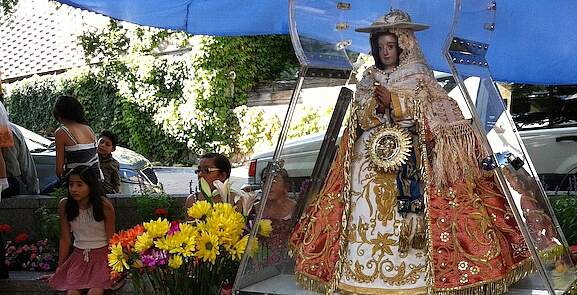
Before dawn on Oct. 12th, thousands of faithful convened at the Cathedral of Guadalajara, Mexico, to start a five-mile pilgrimage to the Basilica of the Virgin of Zapopan in the state of Jalisco, Mexico. The year 2019 has marked the 285th time the pilgrimage has been held.
The pilgrimage began on May 20th when a replica statue, called La Peregrina, or the Pilgrim, began her travels to each parish in the city of Guadalajara. The statue dates from 1541and is an image of Our Lady of the Immaculate Conception.
During the Mexican War of Independence, she was given a blue sash and the title La Generala, "The General," to represent her role as a protector of the military. In 1919, the Vatican decreed the canonical coronation of Our Lady of Zapopan and she was given a golden crown. The statue was used by a discalced Franciscan friar, Fr. Antonio de Segovia, for almost a decade in his missionary work preaching to the local peoples. He wore the small statue around his neck in a wooden box and showed it to the people he preached to. Many of those people saw rays of light emitting from the statue while Friar Segovia preached and converted to the Catholic faith.
In one instance, in 1541 during the Mixton War, a fierce battle broke out between the Indians and the Spanish. Accompanied by Friar Miguel de Bologna, Friar Segovia went into the midst of the Indians carrying only his breviary, a crucifix and the statue. He pleaded with them to lay down their arms, and they were moved to repentance.
Throughout the years, Our Lady of Zapopan has been credited with countless miracles. In 1609, she survived unscathed when the chapel built by the Zapopans collapsed on top of her. Shortly afterward, she returned sight to a blind man. She is credited with stopping epidemics of measles and smallpox in Guadalajara and protecting the city from lightning storms. In 1721, the people of Guadalajara suffered a deadly plague that was killing many inhabitants of the city. The bishop of Guadalajara ordered the statue to visit the city. While she was there, local doctors found that the plague had stopped. In 1653, Bishop Juan Ruiz Colmenero declared the statue "miraculous" and decreed that a feast would be held in her honor on Dec. 18th every year.
Adapted from Church Militant